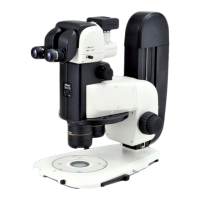Chapter 7 Specific Operations
79
10
Using the Aperture Diaphragm
The SMZ18 and SMZ25 Zooming Bodies contain an aperture
diaphragm.
Turn the aperture diaphragm dial to adjust the aperture.
The aperture can be adjusted in the range from fully open to 3
mm dia.
Opening and closing the aperture diaphragm causes the
brightness and focus depth to change resulting in a change in
resolution.
Open ⇔ Close
Brightness Bright Dark
Focus depth Shallow Deep
Resolution High Low
Adjusting the aperture diaphragm
11
Using Episcopic Illumination
The microscope system enables episcopic illumination when
used with the devices listed below. All of the devices use LEDs as
the light source and provide uniform illumination.
Illumination led from the light source by the fiber is emitted to a
sample through an objective or directly so that an image resulting
from the light reflected from the sample is observed. Episcopic
illumination is used for observing samples which do not transmit
light such as metal and mineral sections.
In addition, if the P2-CIA Coaxial Epi Illuminator is attached,
illumination along the optical axis for observation can also be
emitted, which is effective for observing samples such as metallic
mirrors, resins having smooth surfaces, and semiconductor
wafe
s.
See Chapter 8, “7 Episcopic Illuminator” and select the
appropriate device based on the objective of microscopy.
• P2-CIA Coaxial Epi Illuminator
• C-FDF Flexible Double Arm Fiber Illumination Unit
• C-FID2 Double Arm Fiber Illuminator
• P2-FIR Ring Fiber Illumination Unit
• P2-FIRL2 LED Ring Illumination Unit 2
• C-LSL2 LED Epi Illuminator 2
For the operations of the light sources such as brightness
adjustment, refer to the instruction manuals of the light sources.
Episcopic illumination with
the P2-CIA Coaxial Epi Illuminator
perture
dia
hra
m dial

